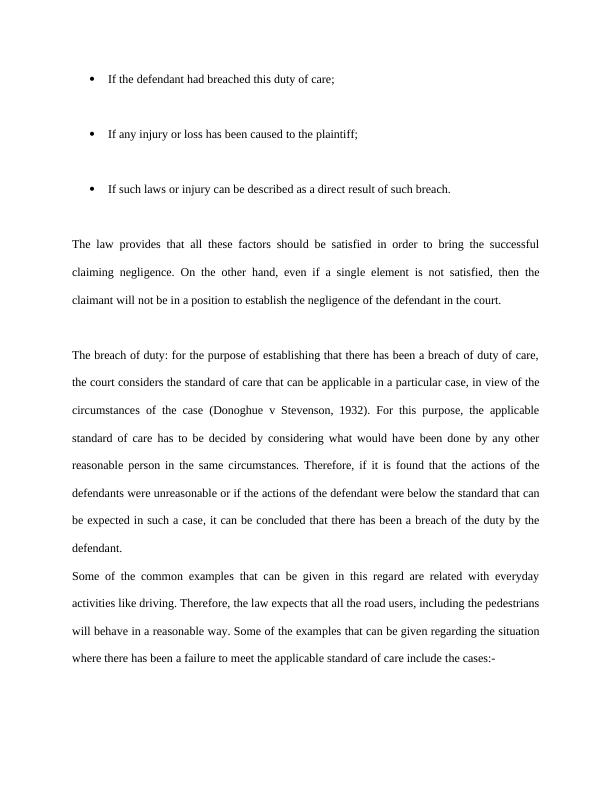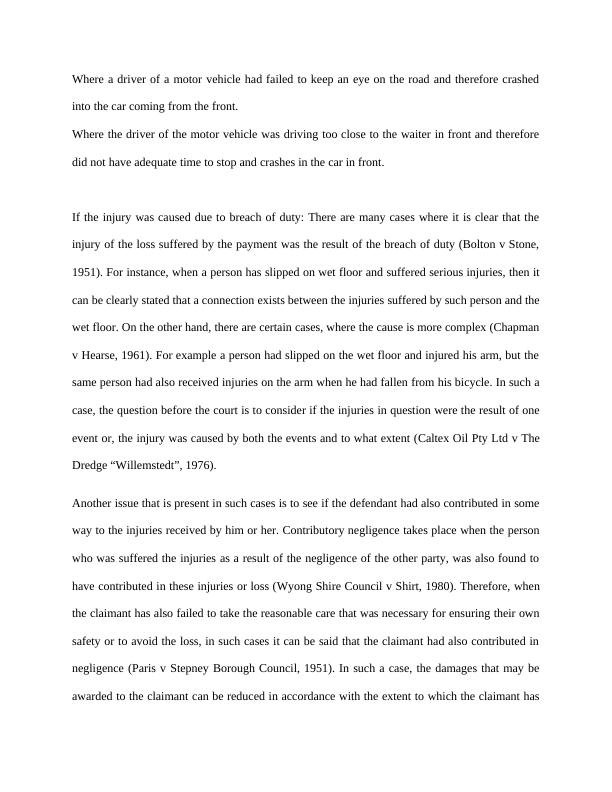A Study of Business Torts
Added on 2020-04-01
8 Pages2365 Words378 Views
The Question A study of torts as they apply to business situations, in particular the torts of negligence andmisrepresentation, but with some reference to other appropriate torts as applicableNegligence can be described as situation where one person has a duty of care towards the otherperson, and in such a case, something is done or there is a failure to do something that wouldhave been done by any other reasonable person and as a result, damage in jail or laws has beencaused to the other person. At the same time, the provisions of Civil Liability Act can also beused to evaluate the negligence of a person and the liability faced were such a person due to thenegligence of such person. When a person sues the other for negligence, the person seeksfinancial compensation for the injury caused the loss suffered by it. In such cases, the claimantwants to be placed in the same position where it would have been if there was no negligence onthe part of the other person. Some of the examples of negligence in daily life can be given in theform of the situation where a car accident has taken, causing personal-injury or damage toproperty. Another example of negligence can be given in the form of medical negligence, whereloss or injury was caused to a patient. At this way, there are four elements that need to be satisfied for bringing a successful claimingnegligence. For this purpose it needs to be seen if:-If the defendant owed the plaintiff, a duty of care

If the defendant had breached this duty of care;If any injury or loss has been caused to the plaintiff;If such laws or injury can be described as a direct result of such breach.The law provides that all these factors should be satisfied in order to bring the successfulclaiming negligence. On the other hand, even if a single element is not satisfied, then theclaimant will not be in a position to establish the negligence of the defendant in the court. The breach of duty: for the purpose of establishing that there has been a breach of duty of care,the court considers the standard of care that can be applicable in a particular case, in view of thecircumstances of the case (Donoghue v Stevenson, 1932). For this purpose, the applicablestandard of care has to be decided by considering what would have been done by any otherreasonable person in the same circumstances. Therefore, if it is found that the actions of thedefendants were unreasonable or if the actions of the defendant were below the standard that canbe expected in such a case, it can be concluded that there has been a breach of the duty by thedefendant. Some of the common examples that can be given in this regard are related with everydayactivities like driving. Therefore, the law expects that all the road users, including the pedestrianswill behave in a reasonable way. Some of the examples that can be given regarding the situationwhere there has been a failure to meet the applicable standard of care include the cases:-

Where a driver of a motor vehicle had failed to keep an eye on the road and therefore crashedinto the car coming from the front.Where the driver of the motor vehicle was driving too close to the waiter in front and thereforedid not have adequate time to stop and crashes in the car in front.If the injury was caused due to breach of duty: There are many cases where it is clear that theinjury of the loss suffered by the payment was the result of the breach of duty (Bolton v Stone,1951). For instance, when a person has slipped on wet floor and suffered serious injuries, then itcan be clearly stated that a connection exists between the injuries suffered by such person and thewet floor. On the other hand, there are certain cases, where the cause is more complex (Chapmanv Hearse, 1961). For example a person had slipped on the wet floor and injured his arm, but thesame person had also received injuries on the arm when he had fallen from his bicycle. In such acase, the question before the court is to consider if the injuries in question were the result of oneevent or, the injury was caused by both the events and to what extent (Caltex Oil Pty Ltd v TheDredge “Willemstedt”, 1976). Another issue that is present in such cases is to see if the defendant had also contributed in someway to the injuries received by him or her. Contributory negligence takes place when the personwho was suffered the injuries as a result of the negligence of the other party, was also found tohave contributed in these injuries or loss (Wyong Shire Council v Shirt, 1980). Therefore, whenthe claimant has also failed to take the reasonable care that was necessary for ensuring their ownsafety or to avoid the loss, in such cases it can be said that the claimant had also contributed innegligence (Paris v Stepney Borough Council, 1951). In such a case, the damages that may beawarded to the claimant can be reduced in accordance with the extent to which the claimant has

End of preview
Want to access all the pages? Upload your documents or become a member.
Related Documents
Tort Law: Negligence and Liabilitylg...
|8
|1794
|32
Commercial Law Issues - Assignmentlg...
|13
|2932
|18
Principle of Negligence | Tort Law Assignmentlg...
|8
|1998
|311
Business Law Assignment 2018: Potential Plaintiffs in Case of Negligencelg...
|5
|1227
|254
English Tort Law Assignmentlg...
|9
|2899
|81
Case Study Assignment on Tort of Negligence and Australian Consumer Lawlg...
|11
|3022
|114
